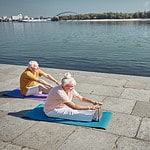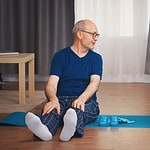Knowing Your Limits
Knee pain? Mobility drills can help – but only if you do them right! Do it wrong and you could actually make your knee worse. Knowing your limits is key.
So here’s the scoop on common mistakes to avoid when doing knee drills:
Understand your body’s capabilities
When doing mobility drills for knee pain, you should know your body’s limits. Begin with a small range of motion and slowly increase it over time. Pay attention to how your body is feeling. If anything causes pain or discomfort, quit right away and look for other exercises that target the same muscles without hurting the injury.
Go slow rather than try too much too soon. If you are having trouble with a drill or feeling pain with an exercise, consult a physical therapist. They can show you how to do the exercises properly and safely progress without aggravating the injury.
Start slowly and gradually increase intensity
When beginning a mobility routine, it is key to start off slow and gradually increase the intensity. Going too hard too soon can bring on more knee pain and hinder progress. It’s best to ease into the exercises to grasp your limitations and identify any areas of weakness or tightness that may need more attention. This approach is optimal for a safe, effective, and long-lasting outcome.
Before beginning mobility drills, it is essential to warm-up. This could include light stretching or light cardio such as walking or jogging. As well as this, foam rolling can help release any knots in the muscles prior to performing exercises targeting the knee joint complexes.
The main goal of most mobility drills for knee pain is to increase range of motion and activate the muscles that support movement. There are several exercises that can be done for this purpose. Each person needs to find which exercise works best for their issue. Common choices include:
- Leg swings
- Lunges with mobility drills
- Range of motion drills using a resistance band or orthopedic wrap (PRI Band)
- Squat variations
- Single leg/joint stability work (clam shells/fire hydrant), etc.
However, these all need to be tried cautiously at first. When you have identified the type of exercise that works well for you, start off with low intensity. If using bands, begin with lighter resistances. Gradually increase intensity over time to get the most out of your routine without putting strain on your knees.
Poor Form
Bad technique is a typical error when doing mobility drills for knee ache. Wrong form can cause more harm, or even make the pain worse. It is key to be sure you are doing each drill correctly, so that they are safe and useful.
Let’s see how to evade this regular blunder:
Properly align your body
Good form is essential for rehabbing knee pain through exercises like swings, squats, and lunges. Bad form can increase injury, and decrease the effectiveness of the movements. So, to align your body correctly while doing these drills, here’s what you should do:
- Keep your chest up, not hunched
- Bend your knees and hips at the same time, avoiding “popping” or jerky motions
- Brace your abs for a stable core
- Keep your spine straight while doing the exercise, avoiding any arching or rounding
- Keep both feet planted on the floor during weight shifts
- Make sure your feet are hip-width apart, and keep a hinge in the hips, not over-arching or locking the legs out.
Maintain a neutral spine
Focus on your body mechanics for any mobility drills to stop knee pain. Keep your head and chest level. Don’t arch or slouch your spine. Inefficient force production can increase knee pain.
- Brace your core muscles before the maneuvering.
- Create full hip extension and don’t bend your knees too much.
- Control your speed and range of motion.
- Practice proper breathing. Inhale when lengthening, exhale when shortening.
Keep your core engaged
Engaging your core during mobility drills is essential for reducing knee pain and enhancing performance. Poor form can cause injury or worsen existing pain.
The core muscles around the hips and abdomen must work together to maintain posture, stability, strength, and flexibility. Movements should come from the hips, not the knees or feet. A strong core helps protect your lower body joints.
To engage your core:
- Pull your navel in
- Keep your torso tall
- Keep a neutral spine position
- Keep hips level
- Move slowly and gradually
- Feel balanced while performing
For any physical activity, proper form is key. Follow the guidance of professional therapists or trainers for safety.
Not Adapting Movements
Knee pain? Mobility drills can help! But, beware – if you don’t customize your drills to fit your body’s needs, you may get little relief and risk further injury. So, let’s look at the mistakes to avoid:
Modify movements to suit your needs
Adapting exercise body positions and movements to suit your individual needs is key for a successful workout. Everyone has different body mechanics, flexibility, strength, size, and goals. It’s crucial to consider these differences when selecting exercises. Your doctor, personal trainer, or physical therapist can help you modify an exercise if needed.
When modifying exercise body position/movements, there are several things to think about:
- Check the form and technique, as accuracy matters for fatigue management and injury prevention.
- Monitor the tension throughout the movement range – if tension increases or it’s hard to complete the movement, reduce the intensity by slowing down, shortening the range of motion, or changing the exercise.
- Focus on recovering between sets for effective muscle growth and avoiding overtraining.
By adapting your movements daily, you can target muscles more accurately, prevent overuse injuries, promote strength gains, maximize muscular balance, strengthen weak muscles, increase flexibility, help postural awareness, reduce injury risk, and allow normal joint function with full range of motion. Plus, you can increase your caloric burn rate and metabolism optimization. In the end, these modifications will help you improve fitness performance today and long-term health tomorrow!
Focus on quality over quantity
It’s vital to prioritize quality over quantity when it comes to physical movement. Unskilled form and rushing can impede results and increase the risk of injury. Pay attention to how you move for the best results.
When attempting something new, take time to polish your form. Establishing a solid foundation and letting muscle memory connect will benefit you in the long run. If you have difficulty with a particular exercise or are adapting a move, don’t give up quickly. A simple adjustment to waist rotation or core activation may make all the difference.
In addition to focusing on quality, include a variety of movement patterns in your routine. This will help build strength and create balance throughout your body, while also evenly challenging all your muscle groups for improved performance and extended longevity.
- Incorporate unilateral exercises like lateral lunges or single-arm rows. This will ensure each side of your body works equally, while also enhancing coordination and stability as they collaborate.
Excessive Force and Loading
Doing mobility drills for knee pain? Watch out for too much force and loading. Some think more effort will lead to better results. But this isn’t always true. It can cause more pain.
To stay safe and get the best outcomes, try to avoid excessive force and loading when doing mobility drills.
Avoid putting too much weight on your joints
When doing drills to reduce knee pain, focus not only on the movement, but also on the weight and force. Too much force and loading can damage soft tissues, like muscles, ligaments, and tendons. This can cause inflammation and injury.
So, when doing exercises, keep the load at a comfortable level. Use low-resistance bands or dumbbells during weighted exercises. And use proper form. Don’t push yourself too hard.
Also, warm up prior to each drill. Dynamic stretching exercises – arm swings and jogging – will help reduce stiffness in your joints. Following these tips will help reduce pain in your knees while avoiding excessive force and loading.
Move slowly and with control
When performing knee pain exercises, be mindful of your form. Don’t move too quickly, as that can cause harm. Don’t use too much force either. Move into each position slowly and hold for 15-20 seconds. Engage your core and press away from the floor with all four corners of your limbs/feet. Focus on maintaining control and understand what each exercise is stimulating. Use mindfulness to reduce joint instability.
Not Stretching
Stretching is a must for any exercise routine, and especially if you have knee pain. When doing mobility drills, stretching correctly before and after is essential. Ignoring this can cause your knee pain to worsen or even result in further injury.
What can happen if you don’t stretch? Let’s take a look:
Stretch before and after mobility drills
Stretching is key for best results and to prevent injury. It warms up the muscles, ligaments, and tendons which increases blood flow to targeted areas and reduces tension. This prepares the body for exercise. After completing a workout or mobility drill, stretching can help cool down the body and reduce potential soreness.
Stretching can also reduce chronic knee pain. During a stretch held 10-30 seconds (or longer), muscles become softer and more pliable. This increases knee range of motion during exercise and daily activities. With proper stretching over time, it can strengthen knee muscles used in movement such as quads, lateral hamstrings, adductors, glutes, obliques, and hip flexors. These are important for improved mobility through the entire leg structure.
Incorporate dynamic and static stretching
Static and dynamic stretching can aid flexibility, muscle tone, and range of motion. A good warm-up is key to avoiding injury or re-injury.
Static stretching should be done before and after physical activity. It targets muscles and joints to reduce tension in the area. Each stretch should take 10-30 seconds with a slight pulling feeling. This helps with musculoskeletal pain and posture.
Dynamic stretching is a form of soft tissue mobilizing exercise. It uses movement patterns that mimic sports activities like running, jumping, and lunging. It takes less time than static stretching. It loosens tight muscles and reduces resistance for each repetition. It also boosts reaction time for quick movements.
Frequently Asked Questions
Q: What are some common mistakes to avoid when performing mobility drills for knee pain?
A: Some common mistakes to avoid when performing mobility drills for knee pain include not warming up before exercise, not stretching after exercise, and not performing the exercises with proper form. Additionally, it is important to avoid performing too much of a certain exercise, as this can lead to further injury and pain.
Q: What should I do if I experience an increase in pain while performing mobility drills?
A: If you experience an increase in pain while performing mobility drills, it is important to stop the exercise immediately and rest. Additionally, you should consult with a healthcare professional to ensure that the exercises are appropriate for your condition and to discuss any changes to your plan of care.
Q: What are some tips to ensure I perform the exercises with proper form?
A: Some tips to ensure you perform the exercises with proper form include focusing on alignment, engaging the core, and maintaining a slow and controlled pace. Additionally, it can be helpful to have a friend, family member, or healthcare provider watch you perform the exercises to ensure you are performing them correctly.





